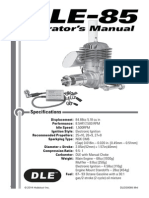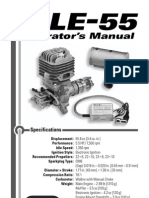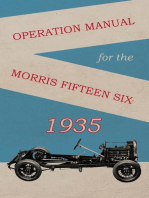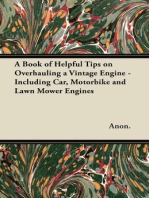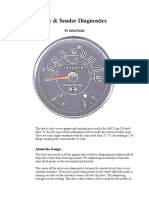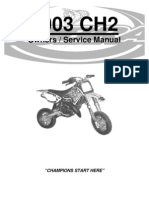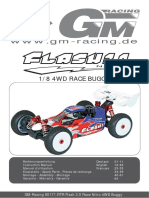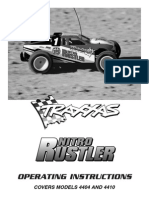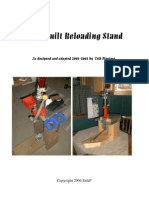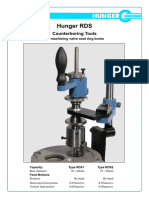Dleg0020 Manual v1 1
Dleg0020 Manual v1 1
Uploaded by
Edgar Alexander Grisales VallejoCopyright:
Available Formats
Dleg0020 Manual v1 1
Dleg0020 Manual v1 1
Uploaded by
Edgar Alexander Grisales VallejoCopyright
Available Formats
Share this document
Did you find this document useful?
Is this content inappropriate?
Copyright:
Available Formats
Dleg0020 Manual v1 1
Dleg0020 Manual v1 1
Uploaded by
Edgar Alexander Grisales VallejoCopyright:
Available Formats
DLE
-
20
Operators Manual
Specifications
20cc [1.2 cu. in.]
2.5 HP / 9,000 rpm
1,700 rpm
Electronic Ignition
14
10, 15
8, 16
6, 16
8, 17
6
CM6
(Gap) 0.018in. 0.020 in. [0.45mm0.51mm]
1.26in. [ 32mm]
0.98in. [ 25mm]
10.5:1
DLE MP 148 100424 with Manual Choke
Main Engine 1.43 lb [ 650g]
Muffler 1.76 oz [50 g]
Electronic Ignition 4.23oz [120 g]
87 93 Octane Gasoline with a 30:1
gas/2- stroke (2- cycle) oil mixture
Displacement:
Performance:
Idle Speed:
Ignition Style:
Recommended Propellers:
Spark Plug Type:
Diameter Stroke:
Compression Ratio:
Carburetor:
Weight:
Fuel:
2011 Hobbico
, Inc. DLEG0020 Mnl 1.1
2
Parts List
(1) DLE-20cc Gas Engine w/DLE MP 148 100424
(1) DLE Spark Plug (NGK CM6 size) with additional spring
(1) Mufer with gasket
(2) 4 x 14 mm SHCS (mufer mounting)
(1) Electronic Ignition Module with additional tachometer lead
(1) Silicone Pick-up Wire Cover / Ignition Wire Cover
(1) Red Three Pin Connector Lead with Pig Tail (ignition switch)
(1) Long Throttle Arm Extension with installation screw and nut
(2) Three Pin Connector Securing Clips
(1) DLE Decal (not pictured)
Safety Tips and Warnings
This engine is not a toy. Please place your safety and the safety
of others paramount while operating. DLE will not be held
responsible for any safety issues or accidents involving this engine.
Operate the engine in a properly ventilated area.
Before starting the engine, please make sure all components
including the propeller and the engine mount are secure and
tight. It is strongly recommended that a screw sealant is used
(Great Planes
Threadlocker GPMR6060) during engine installation.
During the break-in period, it is recommended that the engine be
installed on the aircraft or a test stand with an appropriate shock
absorber. Otherwise it is probable that vibration could rebound
back to the engine and serious damages may occur during the
break-in period.
3
For your safety and the safety of others, please do not stand in
front or in line with the propeller when the engine is running. Keep
onlookers away from the running engine, especially small children.
Always use a balanced spinner and a balanced propeller. An
unbalanced spinner and propeller combination will cause high
levels of vibration and may cause the propeller shaft to break.
Always use a lightweight spinner on your engine. Lightweight
spinners are considered to be those with a cone wall of 1mm
or less. Heavy spinners could cause the propeller shaft to break.
Securely tighten the spinner and propeller on the engine to prevent
it from being thrown off the engine while running.
Never use a propeller that has hit the ground. Even though it
may look good from the outside, it may be cracked on the inside
which may cause it to disintegrate while in use. Do not use a
nicked, cracked or split propeller.
Keep foreign objects away from the propeller. Make sure that
nothing can be sucked in by the propeller.
Never start the engine on loose gravel or sand.
Do not attempt to stop the engine by throwing anything into the
path of the propeller.
Make sure the fuel line is well-secured to the engine and to the
fuel tank so that it wont come off in ight.
Do not use silicone fuel line because it will be dissolved by the
fuel. Use gasoline approved vinyl or neoprene rubber fuel line.
Always secure the fuel line away from the cylinder. The engines
heat can damage the fuel line.
Never touch the engine immediately after a run. The engine will
be hot.
Before transporting your model, remove all the fuel from the
fuel tank and fuel lines.
Always use high-quality oil intended for 2-stroke (2-cycle) engines.
Its a good idea to use a petroleum based 2-cycle motor oil like
Lawn Boy All Season Ashless, Generation II oil for the break-
in period. Break-in should be considered about the rst 3-5
gallons you run the engine. A high quality synthetic 2-cycle oil is
recommended for optimum performance and a longer engine life.
Synthetic 2-cycle oils leave fewer combustion byproducts than
natural oil which can foul the engine and exhaust ports, resulting
in reduced performance. Synthetic oils also reduce friction and
provide more uidity at low temperatures.
Do not install your throttle servo or kill switch servo inside the
engine compartment. Doing so could cause radio interference.
4
Install all electronic radio devices as far away from the engine
as possible.
The throttle and choke pushrods should be non-metallic.
If the engine is not to be used for more than a month, drain the
fuel tank and remove any fuel from inside the carburetor. Do this
by running the engine at idle until it quits by running out of fuel.
Keeping gasoline inside the carburetor over an extended period of
time will damage the diaphragm valve and clog passages inside
the carburetor. Due to the carburetor being more complicated
than those used in glow engines, keep the fuel clean by using a
fuel lter. Use a lter intended to be used with gasoline engines.
Metal lters intended for glow engine are too coarse and will not
screen out ner particles.
Always lter your fuel by using an appropriate lter before putting
it into the airplanes fuel tank.
Gasoline is extremely ammable. Keep it away from an open
ame, excessive heat or sources of sparks.
Do not smoke near the engine or the fuel tank.
This engine was designed for use in a model aircraft. Do not
attempt to use it for any other purpose.
Always install an ignition system kill switch on the aircraft used.
Caution: Running the engine with a lean gas mixture will cause
the engine to overheat and burn the electrode of the spark plug.
Pay close attention to the High-speed Needle adjustment. Running
the engine with the proper gas mixture will cause the spark plugs
to appear yellow at the ignition point.
For optimum performance please use fresh or recently purchased
93 octane gasoline (87 octane gasoline will sufce) with a 30:1
gas/oil mixture.
GAS/OIL Mixing Chart
1 Gallon Gasoline (128 oz/3.78L) / 2-Cycle Oil
(4.26oz/125.68ml) = 30:1 ratio
Excessive running of the engine at idle speed can result in a
seriously carbonized spark plug.
Keep the surface of the engine clean to ensure proper heat
dissipation. Ensure proper cooling/ventilation around the cylinder
with adequate air exhaust.
To avoid permanent damage to the electronic ignition system,
NEVER rotate the propeller on your DLE engine with the electronic
ignition system switched on and the plug not installed in the
plug cap.
5
Installation Instructions
Prepare the engine for installation
Before beginning installation its a good idea to plan location of the
various components of the engine. Many of the following steps may
need to be completed in a different order than listed.
1. Check to see that all screws and bolts are tight. Check carefully
for any cracks, broken, or missing parts. Tighten or replace any
damaged or missing parts before proceeding.
2. Install the silicone wire cover over the pick up lead coming from
the engine (cut the excess silicon wire cover) and connect the lead
to the pickup lead from the Electronic Ignition Module. Secure
the connection with the included three pin connector securing clip.
6
3. Connect the kill switch lead to the red connector from the ignition
control module using the lead from the kill switch or with the included
three pin connector with pig tail. Use one of the included three pin
securing clips to secure the connection.
4. Connect the ignition module battery to the kill switch. Any 4.8-
6.0V, 1000mAh and above capacity battery will work well for this.
Use heat shrink tubing to secure this connection.
5. Install the ignition kill switch and charge jack on the aircraft so
that it is easily accessible from the outside of the plane.
6. Install the ignition module securely in the airplane forward area. It
is recommended that a thin piece of foam rubber is placed between
the module and the mounting surface and that Velcro
is used to
hold the module in place.
7
7. Secure all connections with heat shrink tubing (not supplied).
8. Install the silicone
ignition wire cover over
the ignition wire.
9. Install the spark plug
into the engine head (7-8
lbs torque).
Ignition Wire
(To Spark Plug)
Ignition Control Switch Wire
(To On/Off Switch)
Pick-Up
Sensor Wire
(To Sensor On Engine)
Tachometer
Lead/
RPM
Signal
Out-Put
ELECTRONIC IGNITION
SYSTEM
Battery
Lead
Charge
Lead
Switch
(Not included)
Optional
Tachometer
(Not included)
Installing the DLE-20 on Your Airplane
Note: The DLE-20 must be installed on at least a 6mm [1/4] rewall.
The rewall must be securely glued to the airplane. Use triangle
stock and pin the rewall with hardwood dowels to reinforce the
rewall glue joints. Never install the DLE-20 onto a rewall thinner
than specied because it may fail due to the power of the engine.
1. Select an engine mount. A two-piece engine mount that does not
interconnect or overlap at the rewall is preferred for the DLE-20, like
the Dubro Vibration Reducing Engine Mount 1.20-1.80 (DUBG1307).
2. Before securing the engine mount to the rewall, test t the engine
onto the mount and place the mount onto the rewall. Use this
positioning to create an engine mounting template. Use the template
to drill the mounting holes in the locations on the rewall. Note: A
Template for mounting the DUBG1307 is provided on the back of
this manual. Press the blind nuts into the rear of the rewall. If you
choose to use regular nuts or lock nuts be sure to place washers
8
on the bolts before securing the nuts onto the bolts on the rear of
the rewall. Be sure to use Threadlocker on the screws holding the
engine mount to the rewall.
3. Place the engine on the engine mount and at the recommended
distance from the rewall and test-t the cowling on the aircraft to
verify the distance. When youre satised with the engines position,
mark the location of the four holes on the mount.
4. Remove the engine from the mount. Drill and tap the engine mount
at the position of the four mounting holes. Use an appropriate size
screw (we used (2)1-1/4 and (2) 1 8-32 thread SHCS). Its a good
idea to drill and tap all the way through the mounting beams in
order to secure each screw with a lock nut.
5. Secure the four screws with lock washers, at washers, and lock nuts.
Drain/Vent Pressure Relief Line
Route to top-front of fuel tank interior,
to prevent siphoning.
Carb
Clunk Lines
Fuel Tank
Plug
Supply Line
to Carburetor
Fuel fill line
This line must be extended
to exit the bottom of the aircraft.
6. Install the fuel tank in the airframe. Use only gasoline-safe fuel lines
and a gasoline safe stopper. One line should go to the carburetor and
the other is to be used as a vent (a vent line is simply an open ended
fuel line from the fuel tank which exits the engine compartment or
the fuselage; most vent lines exit at the bottom of the rewall).You
can ll the tank by using the carburetor line as ll line if you have
access to it or install a third line to be used as ll line. Installing a
third line is the cleanest and easiest way to add fuel. An alternative
fueling set up is a 2-line system with a T-tting approved for gasoline
use. Be sure to use a ller plug with either a 2 line or 3 line set-up.
It is a good idea to add an extension to the vent line as shown, that
goes up and to the rear of the tank. This helps to avoid draining fuel
from the tank when the model is pointed down.
9
7. Install the throttle servo as far as possible from the engine. Make
sure that you get the carburetors full range of rotation with your
servo travel. If needed, use the included Long Throttle Arm Extension.
Be sure to use a non-metallic linkage through an outer pushrod
tube and a screw lock connector so that the linkage is adjustable.
Components for the non-metallic linkage can be purchased at your
local hobby shop.
8. Once the throttle servo is installed its a good idea to deactivate the
throttle return spring with a pair of needle nose pliers. Gently grab the
spring and remove it from tension on the throttle lever. Deactivating
the spring will remove the load or stress on the throttle servo.
10
9. Install the choke servo (optional) at the same distance as the
throttle servo from the engine. Be sure to use a non-metallic linkage
and a Faslink to secure the throttle linkage to the servo.
10. Connect the ignition wire from the ignition module to the
spark plug.
11. Install the mufer onto the engine. Be sure to use threadlocker
and that the ignition wire does not contact the mufer.
12. Cut all necessary clearance, carburetor adjustment, cooling,
and exhaust holes in the cowl. A 1:3 ratio of airow intake area to
airow exhaust area is recommended for proper engine cooling.
13. Make sure the cowl is secured to the airplane and that the knurled
thrust washer protrudes from the cowl by at least 3.2mm [1/8].
11
Install the Propeller
1. It is recommended that you test-run, tune, and/or break-in the
engine before ying. To make this easier we recommend that you
remove the cowling.
2. Set the engine near the beginning of the compression stroke.
Note the position of the ignition magnet with the engine inverted.
3. Place the spinner back plate
on the engine and the propeller
on the crankshaft at the one
oclock position.
4. Install the prop washer
and 8x1.0mm adapter nut
(DAVQ9810) on the crankshaft.
5. Install the spinner cone. Be
sure to use thread locker on the
spinner bolt.
3
4 5
12
Adjustment of the Engine
Each DLE Engine has been factory preset. However, differences
in elevation will inuence the performance of the carburetor. To
obtain optimum output of the engine, slight adjustment of the
carburetor may be necessary.
Engine Functions and Adjustments
1. Choke Control (the choke control should be
used when the engine is cold)
2. Throttle
3. Idle Adjustment Screw (adjust the idle speed)
4. (L) Low-speed Needle (adjusts the fuel/air
mixture at low speeds)
5. (H) High-speed Needle (adjusts the fuel/air
mixture at high speeds)
Idle Adjustment
Turning the Idle Adjustment Screw (No.3) clockwise will increase the
idle speed. Turning the Idle Screw counter-clockwise will decrease
the idle speed.
Low Speed Needle Adjustment
Turning the Low-speed Needle (No.4) clockwise will lean the fuel/air
mixture at low speeds. Turning the Low-speed Needle (No.4) counter-
clockwise will richen the fuel/air mixture at low speeds. (The default
or factory setting of the Low-speed Needle is as follows: turn the
needle to the fully stop/closed position and then turn back 1.1 turns.)
High Speed Needle Adjustment
Turning the High-speed Needle (No.5) clockwise will lean the fuel/
air mixture at high speeds. Turning the low-speed Needle (No.5)
counter-clockwise will richen the fuel/air mixture at high speeds.
(The default or factory setting of the High-speed Needle is as follows:
13
turn the needle to the fully stop/closed position and then open the
needle 1.5 turns). It is recommended that the High-speed needle
be adjusted by the use of a tachometer to obtain maximum speed.
Smooth acceleration and deceleration is an indicator of proper
engine performance.
Ignition Timing Adjustment
The ignition timing is preset on the DLE-20 at 38-40 before Top Dead
Center (TDC). The ignition timing can be advanced or retarded by
loosening the (2) ignition sensor Phillips head screws and sliding
the sensor to the full extent clockwise (41 advancing the ignition)
or counter clockwise (37 retarding the ignition). Be sure to retighten
the Phillips head screws after adjusting the ignition timing. It is
best to attach the sensor with the screws centered in the slot as a
starting point.
Advancing the timing causes combustion to occur earlier resulting
in higher performance of the engine. However, advancing the timing
also causes higher engine temperatures and can cause premature
wear of internal engine components.
Carburetor Adjustment Troubleshooting
Problem:
If The engine hesitates when accelerated rapidly.
or The rpm increases at idling.
or The engine stops when the throttle is moved from high to low.
Solution:
The low-speed needle L is too lean. Open it up about 1/8 of a
turn and try again.
Problem:
If The idle is not steady.
Solution:
The low-speed needle L valve is too rich. Close it 1/8 of a turn
and try again.
Problem:
If Engine stops at full throttle.
or Engine hesitates when accelerated rapidly.
or The engine will not come up to full rpm at full throttle.
Solution:
The high-speed needle valve H is too lean. Open it up 1/8 of
a turn and try again.
14
Problem:
If Your engine does not reach full rpm.
or Carbon build-ups appear consistently on your spark plug.
Solution:
The high-speed needle valve H is too rich. Close it up 1/8 turn
and try again.
Starting Procedures
When starting the engine the rst time and during break-in its
recommended that you run the engine without the cowling. Also,
for safety reasons do not adjust the carburetor while the engine
is running.
There are two recommended ways to start the DLE-20:
A. Manual Starting
Note: When hand starting the DLE-20, use a thick glove or heavy
duty starter stick to protect your hand.
1. The propeller should be installed on the drive washer at the one
oclock position and at the beginning of the compression stroke
so that its comfortable to ip it through compression.
2. Have someone help you hold the airplane while you start the
engine.
3. Switch the ignition to ON, close the choke on the carburetor and
open the throttle slightly from the idle position.
4. Flip the propeller counter clockwise several times briskly, until a
popping sound is heard. This indicates that the engine is ring.
5. Move the choke lever to the OPEN position.
6. Set the throttle to a high idle. Set the propeller so that it is at
the beginning of the compression stroke.
7. Flip the propeller through compression rapidly. If this is done
properly, the engine will start after several brisk ips of the
propeller.
8. After starting, let the engine idle for 30 to 45 seconds. Open
and close the throttle slowly until the engine runs smoothly at
idle and at full throttle. Acceleration should also be smooth. If
acceleration is not smooth, adjustments to the carburetor may
be necessary (see Adjustment of the Engine, page 12)
9. If your engine does not start, repeat steps 2-8.
15
B. Electric Starter Starting
A 24V electric starter is recommended to start the DLE-20
1. Make sure you use a good quality, lightweight aluminum spinner.
2. Have someone help you hold the airplane while you start it.
3. Switch the ignition to ON, close the choke plate on the carburetor
and open the throttle slightly from the idle position.
4. Use your electric starter to turn the engine over for several
seconds, until a popping sound is heard. This indicates that the
engine is ring.
5. Move the choke lever to the open position.
6. Set the throttle to high idle and use your electric starter to turn
over the engine until it starts.
7. After starting, let the engine idle for 30 to 45 seconds. Open
and close the throttle slowly until the engine runs smoothly at
idle and at full throttle. Acceleration should also be smooth. If
acceleration is not smooth, adjustments to the carburetor may
be necessary (see Adjustment of the Engine, page 12).
8. If your engine does not start, repeat steps 2-7.
16
Engine Troubleshooting
If your engine fails to start after the preceding starting procedures
please check the following.
Symptom Diagnosis Fix
Engine
does not
fire
Ignition battery
voltage low
Charge or
replace battery
Engine
starts,
then rpm
increases
till engine
cuts out
Fuel not reaching
engine
Check for:
a) fuel in tank
b) fuel tubing
cut, blocked,
or kinked
c) carburetor
clogged
Battery wires faulty
or loose
Replace wires or
Re-connect/check
connections
Faulty spark plug
or not firing
Replace spark plug
or check for spark *
Engine flooded Remove plug,
disconnect fuel
line, rotate prop
to remove fuel
* This can be done by removing the spark plug from the cylinder
and attaching the plug on the outside of the crankcase. Have an
assistant turn the engine over while checking this and be sure to
have the spark plug rmly plugged into the ignition wire.
Warning: The high voltage from the ignition can cause bodily
harm, especially when checking for spark in this manner.
17
Optional Digital Tachometer (not included)
An optional Digital Tachometer
is available that can be directly
connected to the ignition and
display the RPM of the engine.
The Futaba
DSC Charge
Adapter (FUTM4243) can be
mounted in the fuselage and
allows easy external plug-in of
the Digital Tachometer.
Many of the DLE Ignition modules have an additional lead to plug
into the Digital Tachometer. If your ignition module does not have
this additional lead, the Digital Tachometer can still be used. Simply
use the Y-harness (included with the Digital Tachometer) to connect to
the pick-up lead from the engine. Be sure to secure all connections
and to secure the Digital Tachometer or leads on the aircraft used.
18
Engine Maintenance
Please clean the fuel lter in the DLE Carburetor periodically. Failure
to do so may result in miss-calibration of the needle adjustments.
In order to do this it is necessary to remove the Phillips head screw
which secures the carburetor lter cover and the carburetor lter
gasket. Use only carburetor cleaner to clean the opening around
the lter.
19
Warranty Information
The DLE-20 has a two year limited warranty through Hobby Services
beginning at the date of purchase. Please retain your receipt as
your proof of purchase.
Contact Us
Hobby Services
3002 N. Apollo Drive Suite #1 Ph: 217-398-8970
Champaign, Il 61822 Fax: 217-398-7721
E-mail: enginesupport@Hobbico.com
Web address: www.hobbyservices.com
20
1
5
8
1
8
1
1
3
0
2
1
1
7
2
2
1
4
9
2
6
3
2
1
3
1
2
3
2
9
1
0
1
2
0
1
9
7
54
2
7
2
8
2
6
2
5
1
6
2
4
2
3
21
Replacement Parts
Stock
No.
Key
No. Description
DLEG2001 1 Cylinder
DLEG2002 2 Crankshaft
DLEG2003 3 Crankcase
22 Back Plate
DLEG2004 4 Piston
27 Wrist Pin
28 C-Clips
DLEG2005 5 Piston Ring
DLEG2006 6 Electronic Ignition Module
DLEG2007 7 Mufer
19 Mufer Gasket
DLEG2008 8 Carburetor Complete
DLEG2009 9 Connecting Rod
DLEG2011 11 Reed Valve Assembly
21 Carburetor Block
DLEG2012 25 Front Bearing Set
12 Rear Bearing Set
DLEG2013 13 Electronic Ignition Sensor
DLEG2014 14 Back plate O-Ring
DLEG2015 15 Screw Set
DLEG2016 Propeller Drive Hub Assembly
16 Thrust Washer
24 Prop Washer
DLEG2017 26 Needle Bearing For Connecting Rod
DLEG2018 Gasket Set
17 Carburetor Block Gasket
18 Carburetor Gasket
19 Mufer Gasket
20 Head Gasket
30 Reed Valve Gasket
DLEG2019 29 Woodruff Key
DLEG2020 23 Propeller Jam Nuts (2)
DLEG2021 32 Spark Plug Cap
DLEG5510 10 Spark Plug
Optional Parts
DLEG5525 Digital Tachometer (See page 17)
22
3.56 in.
[90 mm]
2.25 in.
[57 mm]
0.98 in.
[25 mm]
2.20 in.
[56 mm]
2.37 in.
[60 mm]
23
DLE-20 Mounting Pattern
with DUBG1307 Engine Mount
2.75 in.
[70 mm]
2.75 in. [ 70 mm]
You might also like
- CW POKEMON - V5.03 User ManualDocument58 pagesCW POKEMON - V5.03 User ManualEdgar Alexander Grisales Vallejo100% (2)
- 2013 Spyder ST Owners ManualDocument171 pages2013 Spyder ST Owners ManualMelvin Quezada67% (6)
- LCD Display User Manual NOKEE UDocument19 pagesLCD Display User Manual NOKEE UMavriskoni SofosNo ratings yet
- Argus Model Engine Instruction ManualDocument4 pagesArgus Model Engine Instruction Manualmerrecoleca100% (1)
- Motronic3 1Document20 pagesMotronic3 1heiansandan100% (3)
- LG4HKED-WE-VN53 - Engine Control System 4HK1Document404 pagesLG4HKED-WE-VN53 - Engine Control System 4HK1tuannholtt100% (9)
- SM - 8 (2) Mitsubishi Fuso 2001Document241 pagesSM - 8 (2) Mitsubishi Fuso 2001bakriramzi100% (9)
- Argus Model Engine Instruction ManualDocument4 pagesArgus Model Engine Instruction Manualmerrecoleca100% (1)
- 09a Engine Ewj 3.1L TDDocument68 pages09a Engine Ewj 3.1L TDDavor Giaconi100% (1)
- Manual Motor Fuji 50Document12 pagesManual Motor Fuji 50Jorge Guerra SepulvedaNo ratings yet
- Disassembly Sub 2000Document13 pagesDisassembly Sub 2000Glen CorsonNo ratings yet
- Audi Q7 Battery Terminal Engine ManagementDocument18 pagesAudi Q7 Battery Terminal Engine ManagementAnonymous t1FCvPRSa100% (2)
- 60d1a18b-cb42-4fc3-a01c-49c9b37f5594Document8 pages60d1a18b-cb42-4fc3-a01c-49c9b37f5594Tarso BrasilNo ratings yet
- Safety Instructions and WarningsDocument28 pagesSafety Instructions and WarningsSherlock HólmesNo ratings yet
- Dleg0085 ManualDocument24 pagesDleg0085 ManualEdgar Alexander Grisales VallejoNo ratings yet
- XTM 21 ManualDocument6 pagesXTM 21 ManualCristian Luis ChenuNo ratings yet
- DLE 30 ManualDocument24 pagesDLE 30 ManualKang YAyanNo ratings yet
- DLE 55 G0055-ManualDocument24 pagesDLE 55 G0055-ManualAbel Gonzalez OnrubiaNo ratings yet
- RCGF21TWINDocument21 pagesRCGF21TWINejunsunNo ratings yet
- Zenoah G230PU Petrol EngineDocument4 pagesZenoah G230PU Petrol EngineJarkko PuustinenNo ratings yet
- OS Rotary Engine 49-PI Ype!!Document20 pagesOS Rotary Engine 49-PI Ype!!franco.didio1945No ratings yet
- Da 60Document10 pagesDa 60Köves IstvánNo ratings yet
- Thunder Tiger - +-+PRO-21+og+28BX-RP+bilmotorDocument4 pagesThunder Tiger - +-+PRO-21+og+28BX-RP+bilmotorPeter JoselitoNo ratings yet
- Ondemandware - Staticsites Horizon Us SiteSites Horizon masterdefaultManualsDLEG0020 Manual ENDocument24 pagesOndemandware - Staticsites Horizon Us SiteSites Horizon masterdefaultManualsDLEG0020 Manual ENpaulo_gallina_2No ratings yet
- A Book of Helpful Tips on Overhauling a Vintage Engine - Including Car, Motorbike and Lawn Mower EnginesFrom EverandA Book of Helpful Tips on Overhauling a Vintage Engine - Including Car, Motorbike and Lawn Mower EnginesRating: 5 out of 5 stars5/5 (1)
- Magnum .61 4TDocument8 pagesMagnum .61 4TJoseAlfredoCarneiroDosSantosNo ratings yet
- Colt Woodsman Match Target... 3rd Series, 6-Inch..Document34 pagesColt Woodsman Match Target... 3rd Series, 6-Inch..anon_835518017No ratings yet
- XTM X Cellerator Nitro ManualDocument20 pagesXTM X Cellerator Nitro ManualCharly RodriguezNo ratings yet
- Jeep CJ Gauge Sender Diagnostics 72 86 by John Foutz 1300221252Document6 pagesJeep CJ Gauge Sender Diagnostics 72 86 by John Foutz 1300221252Steve HirstNo ratings yet
- 2003 - ch2 - Ownersmanual +aprilia RX 50Document31 pages2003 - ch2 - Ownersmanual +aprilia RX 50daverdlcNo ratings yet
- M48 Disassembly ReassemblyDocument7 pagesM48 Disassembly ReassemblypoinkerNo ratings yet
- Jc60evo ManualDocument12 pagesJc60evo ManualGerman ParamoNo ratings yet
- Safety Instructions and WarningsDocument43 pagesSafety Instructions and WarningsMarcelo Gomes MorenoNo ratings yet
- Cam ViseDocument14 pagesCam Visesundar_subash25No ratings yet
- Fa30s HDocument24 pagesFa30s HwebergraficNo ratings yet
- English ManualDocument40 pagesEnglish ManualSEPIRTUSNo ratings yet
- Dillon Square Deal B Manual May 2007Document16 pagesDillon Square Deal B Manual May 2007ITLHAPNNo ratings yet
- 50sx 40-91fx PDFDocument22 pages50sx 40-91fx PDFHemant SharmaNo ratings yet
- Flash3.0 Nitro enDocument46 pagesFlash3.0 Nitro enRaúl MuñizNo ratings yet
- WheelHorse Electric Clutch Conversion For Post 1970 Tractors 8-3513Document4 pagesWheelHorse Electric Clutch Conversion For Post 1970 Tractors 8-3513Kevins Small Engine and Tractor ServiceNo ratings yet
- 46 La ManualDocument40 pages46 La Manualfripouille57290No ratings yet
- Pioneer gm-d8400mDocument32 pagesPioneer gm-d8400misdi antoroNo ratings yet
- HB Engine Settings Hyper 12Document4 pagesHB Engine Settings Hyper 12ZfasNo ratings yet
- Traxxas T Maxx 4910Document48 pagesTraxxas T Maxx 4910jheison166No ratings yet
- The Novak Guide To Rebuilding The Jeep: IH Dana 18 Transfer CaseDocument8 pagesThe Novak Guide To Rebuilding The Jeep: IH Dana 18 Transfer Caseccfm03100% (1)
- 120 To 150 EngDocument18 pages120 To 150 EngTEAM COLABNo ratings yet
- MXIIA AssemblymanualDocument79 pagesMXIIA AssemblymanualAndy SetiawanNo ratings yet
- Safety Instructions and WarningsDocument28 pagesSafety Instructions and WarningsEdson ReisNo ratings yet
- Operating Instructions: WarningsDocument8 pagesOperating Instructions: WarningsMarcelo ArevaloNo ratings yet
- O.S fl70 - eDocument23 pagesO.S fl70 - ewebergraficNo ratings yet
- 4410 4404 Nitrorustler15 Oper Inst 020801 - 0Document14 pages4410 4404 Nitrorustler15 Oper Inst 020801 - 0jobaker52No ratings yet
- Homebuilt Reloading Stand by Erik PrestmoDocument18 pagesHomebuilt Reloading Stand by Erik Prestmopeter.gomes20087216100% (1)
- 15cva 32sxDocument20 pages15cva 32sxliuzhenmenglaiNo ratings yet
- Traxxas Tmaxx Pro15Document12 pagesTraxxas Tmaxx Pro15d crosbieNo ratings yet
- Manuel Motor Dle 120 Manual 2.0Document24 pagesManuel Motor Dle 120 Manual 2.0samuel_jalesNo ratings yet
- OS 120 4t ManualDocument13 pagesOS 120 4t ManualJoão EfremNo ratings yet
- .32 Marine Owner's Manual: Setting The Needle ValvesDocument2 pages.32 Marine Owner's Manual: Setting The Needle ValvesGodsniperNo ratings yet
- RDS Product SheetDocument3 pagesRDS Product SheetSoufiane BounezraNo ratings yet
- Mitchell OnDemand Ver (5.8.2.35)Document2 pagesMitchell OnDemand Ver (5.8.2.35)vercruyssenyNo ratings yet
- Motor 4 TDocument8 pagesMotor 4 Tbauti2009No ratings yet
- Aeros Combat 2 Combat LDocument77 pagesAeros Combat 2 Combat LsebastiaanNo ratings yet
- Grassracing Summer 73Document11 pagesGrassracing Summer 73Paul MartinNo ratings yet
- DA70 ManualDocument9 pagesDA70 ManualJunior BatistaNo ratings yet
- AxlesDocument44 pagesAxlesJuan Cruz FonsecaNo ratings yet
- Instructions For: P Paarrttss Ooff Tthhee C CaarrbbuurreettoorrDocument6 pagesInstructions For: P Paarrttss Ooff Tthhee C CaarrbbuurreettoorrJose Fernando TrujilloNo ratings yet
- XR700 and XR3000: Ignition InspectionDocument20 pagesXR700 and XR3000: Ignition InspectionDevine LightNo ratings yet
- IAME KA100 100cc REEDJET Engine Update 8 December 2019 PDFDocument59 pagesIAME KA100 100cc REEDJET Engine Update 8 December 2019 PDFpavli999No ratings yet
- Spring Manual19 1Document15 pagesSpring Manual19 1Edgar Alexander Grisales VallejoNo ratings yet
- Instructions Carb Type 7LDocument2 pagesInstructions Carb Type 7LEdgar Alexander Grisales VallejoNo ratings yet
- Crosswind FlyingDocument28 pagesCrosswind FlyingEdgar Alexander Grisales VallejoNo ratings yet
- Flying With Flaps - Understanding Their Use. - Model Airplane NewsDocument6 pagesFlying With Flaps - Understanding Their Use. - Model Airplane NewsEdgar Alexander Grisales VallejoNo ratings yet
- Induction Systems 5Document23 pagesInduction Systems 5RobertNo ratings yet
- F50F FT50G F60C FT60D: Owner'S ManualDocument86 pagesF50F FT50G F60C FT60D: Owner'S ManualGnl JeanNo ratings yet
- Service Parts: Residential/Commercial Generator SetsDocument68 pagesService Parts: Residential/Commercial Generator SetsRoberto Sanchez ZapataNo ratings yet
- FM44-62 Twin 40-MM Gun Motor Carriage M19Document128 pagesFM44-62 Twin 40-MM Gun Motor Carriage M19dieudecafeNo ratings yet
- Mirage ImplementationDocument6 pagesMirage Implementationazrina_ninaNo ratings yet
- Engine Controls (Powertrain Management) - TDI 20LTDocument8 pagesEngine Controls (Powertrain Management) - TDI 20LTRafael MejiaNo ratings yet
- BcmechDocument47 pagesBcmechIonut GrozaNo ratings yet
- Product Features Et Al ManRidersDocument16 pagesProduct Features Et Al ManRiderspasanac77No ratings yet
- Instalacion Messenger 302-0417Document99 pagesInstalacion Messenger 302-0417emmanuelaNo ratings yet
- OMM126795Document52 pagesOMM126795Mike LaflammeNo ratings yet
- The Audi 1.8L and 2.0L Third Generation Ea888 Engines: Eself-Study Program 920243Document72 pagesThe Audi 1.8L and 2.0L Third Generation Ea888 Engines: Eself-Study Program 920243sergio ulises santi huashuaNo ratings yet
- PIDs For Passenger Car (Rev.1.02)Document13 pagesPIDs For Passenger Car (Rev.1.02)Sasa AhlanNo ratings yet
- Trouble Diagnosis ECM Harness Connector Terminal Layout: PreparationDocument8 pagesTrouble Diagnosis ECM Harness Connector Terminal Layout: PreparationNelson Cacahuate PowerDanceeNo ratings yet
- Catálogo Digital - ENDocument20 pagesCatálogo Digital - ENMaxuel AntunesNo ratings yet
- Kawasaki ZX750E1 Parts ManualDocument120 pagesKawasaki ZX750E1 Parts ManualNick BeckiusNo ratings yet
- Señales de Entrada ECUDocument34 pagesSeñales de Entrada ECUlibertyplusNo ratings yet
- Toaz - Info Trouble Shooting Case PRDocument15 pagesToaz - Info Trouble Shooting Case PRdouahchia rachedNo ratings yet
- Manual Ignijet 2007 enDocument14 pagesManual Ignijet 2007 enJordi RuizNo ratings yet
- Shaanxi Electronic Control Unit PDF Wiring Diagrams PinecuDocument7 pagesShaanxi Electronic Control Unit PDF Wiring Diagrams PinecuJefferson Elbrey0% (1)
- Cherry QQ (S21) 2006-2013 UMC EFI For 473F Engine PDFDocument85 pagesCherry QQ (S21) 2006-2013 UMC EFI For 473F Engine PDFJeni100% (1)
- T-45C Aircraft: Virtual Natops Flight Manual Navy ModelDocument232 pagesT-45C Aircraft: Virtual Natops Flight Manual Navy ModelPedro SousaNo ratings yet
- Electronic Engine Controls 1.8 Ford FocusDocument48 pagesElectronic Engine Controls 1.8 Ford FocusBAO ANH LÊNo ratings yet













